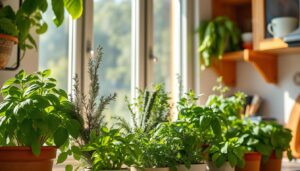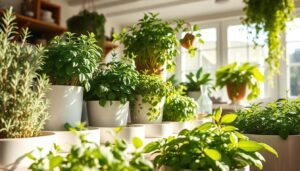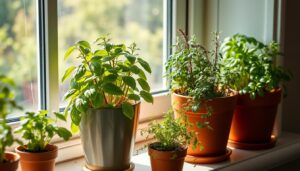Introduction:
In the pursuit of enhancing our culinary adventures and infusing our dishes with vibrant flavors, there exists a delightful herb that beckons to be grown right within the confines of our homes: basil. Whether you’re a seasoned gardener or a novice enthusiast, the prospect of nurturing this aromatic herb indoors presents an exciting opportunity to elevate your cooking and connect with nature on a smaller scale.
Basil, with its fragrant leaves and versatile applications, has long been a staple in kitchens around the world. From pesto sauces to garnishes, its fresh and distinct flavor adds depth and character to a myriad of dishes. However, the convenience of having this herb readily available at your fingertips, even in the heart of winter or within the confines of an apartment, is a luxury that indoor cultivation affords.
In this guide, we’ll delve into the art of cultivating basil indoors, exploring the essential steps, considerations, and tips to ensure a thriving harvest. Whether you’re seeking to enliven your culinary creations or simply indulge in the joy of nurturing green life within your living space, join us as we embark on a journey to cultivate basil right at home.
Choosing the Right Variety:
Before delving into the intricacies of indoor basil cultivation, it’s crucial to select the right variety suited for indoor conditions. Basil comes in various types, each offering distinct flavors, growth habits, and adaptability to indoor environments. Here are some popular varieties to consider:
- Genovese Basil: Renowned for its robust flavor and large, tender leaves, Genovese basil is a favorite among culinary enthusiasts. This variety thrives in indoor settings with ample sunlight and moderate humidity.
- Thai Basil: With its unique licorice flavor and purple-tinged stems, Thai basil adds an exotic twist to dishes. It adapts well to indoor growing conditions and requires regular pruning to encourage bushy growth.
- Lemon Basil: As the name suggests, lemon basil infuses dishes with a refreshing citrusy aroma. This variety flourishes indoors when provided with bright, indirect light and well-draining soil.
- Cinnamon Basil: Characterized by its spicy-sweet flavor reminiscent of cinnamon, this basil variety adds depth to both sweet and savory dishes. It thrives in warm indoor environments with ample sunlight.
- Greek Basil: Known for its compact growth habit and small, aromatic leaves, Greek basil is ideal for small indoor spaces. It requires moderate sunlight and well-draining soil to thrive.
When selecting a basil variety for indoor cultivation, consider factors such as your culinary preferences, available space, and environmental conditions within your home. Opt for compact varieties or those specifically bred for container gardening to maximize space utilization.
Key Considerations for Indoor Cultivation:
Once you’ve chosen the right basil variety, it’s time to address the essential factors that contribute to successful indoor cultivation. Here’s a breakdown of key considerations:
- Lighting: Basil thrives in bright, indirect sunlight, receiving at least 6-8 hours of light per day. Position your indoor garden near south-facing windows or supplement natural light with grow lights to ensure adequate illumination.
- Temperature and Humidity: Maintain indoor temperatures between 65-85°F (18-29°C) to promote optimal growth. Basil prefers moderate humidity levels, so consider using a humidifier or placing a tray of water near your plants to increase moisture in the air.
- Soil and Container: Choose a well-draining potting mix formulated for herbs or vegetables to prevent waterlogged roots. Select containers with adequate drainage holes to prevent water accumulation, and opt for pots that accommodate the size of your basil plant’s root system.
- Watering and Fertilization: Water basil plants consistently, allowing the top inch of soil to dry out between waterings. Avoid overwatering, as it can lead to root rot. Fertilize your basil plants every 2-4 weeks with a balanced liquid fertilizer diluted to half strength during the growing season.
- Pruning and Harvesting: Regularly prune basil plants to encourage bushy growth and prevent flowering, which can diminish leaf production and flavor. Harvest basil leaves as needed, starting from the top of the plant and working your way down. Use sharp scissors to make clean cuts and avoid damaging the stem.
Pest Management and Disease Prevention:
While indoor cultivation offers a controlled environment for growing basil, it’s not immune to pest infestations and diseases. Vigilance and proactive measures are essential to safeguard your basil plants and ensure a healthy harvest. Here’s a guide to managing common pests and preventing diseases in indoor basil cultivation:
Common Pests:
- Aphids: These tiny, sap-sucking insects can quickly colonize basil plants, causing stunted growth and leaf curling. To control aphids, rinse plants with a gentle stream of water to dislodge them or use insecticidal soap as a natural remedy.
- Whiteflies: Whiteflies are small, moth-like insects that feed on the undersides of basil leaves, leaving behind sticky honeydew residue. Use yellow sticky traps to monitor and trap adult whiteflies, and apply neem oil or insecticidal soap to manage infestations.
- Spider Mites: These minuscule pests thrive in dry indoor environments and feed on basil leaves, causing stippling and webbing. Increase humidity levels around basil plants by misting them regularly and use insecticidal soap or neem oil to control spider mite populations.
- Fungal Gnats: These small, black flies lay their eggs in moist soil, leading to larvae infestation and root damage. Allow the soil surface to dry out between waterings to deter fungal gnat breeding, and use sticky traps or beneficial nematodes to control adult flies and larvae.
Disease Prevention:
- Powdery Mildew: Powdery mildew appears as a white, powdery coating on basil leaves, stems, and flowers, thriving in warm, humid conditions. Improve air circulation around basil plants by spacing them adequately and avoid overhead watering to prevent powdery mildew development. Apply fungicidal sprays containing potassium bicarbonate or sulfur as a preventive measure.
- Downy Mildew: Downy mildew manifests as yellow, angular lesions on basil leaves, eventually leading to leaf drop and plant decline. Minimize humidity levels around basil plants and avoid overcrowding to reduce the risk of downy mildew. Apply copper-based fungicides preventively to protect against this fungal disease.
- Bacterial Leaf Spot: Bacterial leaf spot causes dark, water-soaked lesions on basil leaves, compromising their health and flavor. Practice proper sanitation by removing and disposing of infected plant debris promptly. Avoid overhead watering and use drip irrigation to minimize water splash, which can spread bacterial pathogens.
- Fusarium Wilt: Fusarium wilt is a soilborne fungal disease that causes wilting, yellowing, and eventual death of basil plants. Use sterile potting mix and clean containers to prevent fungal contamination, and rotate basil plantings to avoid replanting in the same soil where Fusarium wilt has occurred.
Creative Uses for Indoor Basil:
Beyond its traditional culinary applications, indoor-grown basil offers an array of creative possibilities to elevate your cooking, enhance your home environment, and explore new avenues of enjoyment. Here are some innovative ways to make the most of your indoor basil harvest:
- Herbal Infusions and Flavored Oils:
- Create aromatic herbal infusions by steeping fresh basil leaves in hot water for refreshing beverages or cocktails.
- Infuse olive oil with basil leaves to add a subtle herbaceous flavor to dressings, marinades, and dips.
- Herbal Sachets and Potpourri:
- Bundle dried basil leaves and other aromatic herbs in fabric sachets to create natural air fresheners for your home.
- Mix dried basil with dried flowers and spices to make fragrant potpourri blends for decorative purposes.
- Herbal Vinegars and Syrups:
- Combine fresh basil leaves with vinegar to infuse tangy herbal flavors into homemade salad dressings or pickling solutions.
- Simmer basil leaves with sugar and water to create a fragrant basil syrup for sweetening beverages or drizzling over desserts.
- Herbal Skincare and Bath Products:
- Incorporate dried basil leaves into homemade soaps, scrubs, and bath salts for their aromatic properties and potential skin benefits.
- Infuse basil essential oil into carrier oils or lotions for a refreshing addition to your skincare routine.
- Herbal Teas and Culinary Garnishes:
- Brew fresh or dried basil leaves into herbal teas for a soothing and aromatic beverage option.
- Use fresh basil leaves as decorative garnishes for cocktails, mocktails, desserts, and savory dishes to impart a burst of color and flavor.
- Herbal Pesto Variations:
- Experiment with different basil varieties and additional herbs, nuts, and cheeses to create unique pesto variations.
- Customize pesto recipes by incorporating seasonal ingredients such as sun-dried tomatoes, roasted peppers, or spinach for diverse flavor profiles.
- Herbal Baking and Desserts:
- Infuse baked goods such as cookies, cakes, and bread with basil flavor by incorporating finely chopped fresh or dried basil leaves.
- Create basil-flavored desserts such as sorbets, ice creams, and gelatos for a refreshing and herbaceous twist on classic treats.
- Herbal Cocktails and Mocktails:
- Use fresh basil leaves as a versatile cocktail ingredient for muddling, garnishing, or creating basil-infused simple syrups.
- Craft mocktails featuring basil, citrus, and other complementary flavors for non-alcoholic refreshment options.
Troubleshooting Common Issues:
Even with careful attention and proper care, indoor basil cultivation may encounter challenges that require troubleshooting to ensure the health and vitality of your plants. By identifying common issues early and implementing corrective measures, you can address concerns effectively and promote optimal growth and productivity. Here’s a guide to troubleshooting common problems encountered in indoor basil cultivation:
- Yellowing Leaves:
- Cause: Yellowing leaves may indicate various issues, including overwatering, nutrient deficiencies, or insufficient light.
- Solution: Adjust watering practices to allow the soil to dry out slightly between waterings. Ensure adequate light exposure and consider supplementing with grow lights if natural light is insufficient. Monitor nutrient levels and provide balanced fertilizer as needed to address deficiencies.
- Leggy Growth:
- Cause: Leggy growth, characterized by elongated stems and sparse foliage, typically results from inadequate light or overcrowding.
- Solution: Increase light exposure by positioning plants closer to windows or using supplemental grow lights. Prune leggy stems to encourage bushier growth and improve airflow around the plants. Space basil plants appropriately to prevent overcrowding and competition for light.
- Wilting or Drooping:
- Cause: Wilting or drooping foliage may indicate underwatering, overwatering, or root issues such as root rot.
- Solution: Check soil moisture levels regularly and adjust watering frequency to maintain consistent moisture without waterlogging the roots. Ensure proper drainage in containers to prevent water accumulation. If root rot is suspected, inspect the roots for signs of decay and consider repotting in fresh, well-draining soil.
- Pest Infestations:
- Cause: Pest infestations, including aphids, whiteflies, and spider mites, can weaken basil plants and impact growth and productivity.
- Solution: Monitor plants regularly for signs of pest activity, such as stippling, leaf curling, or honeydew residue. Use natural remedies such as insecticidal soap, neem oil, or beneficial insects to control pest populations. Quarantine affected plants if necessary to prevent the spread of pests to healthy specimens.
- Fungal Diseases:
- Cause: Fungal diseases such as powdery mildew, downy mildew, and Fusarium wilt thrive in warm, humid environments and can spread rapidly in indoor settings.
- Solution: Improve air circulation around basil plants by spacing them adequately and using fans to promote airflow. Avoid overhead watering to minimize moisture on foliage, which can contribute to fungal growth. Apply fungicidal sprays or treatments containing copper-based compounds to prevent and manage fungal diseases.
- Environmental Stress:
- Cause: Environmental factors such as temperature fluctuations, humidity imbalances, or drafts can stress basil plants and compromise their health.
- Solution: Maintain stable environmental conditions within the optimal range for basil cultivation, including temperature, humidity, and airflow. Shield plants from drafts or sudden temperature changes, especially during winter months. Monitor indoor climate conditions using a thermometer and hygrometer to identify and address potential stressors.
Harvesting and Preserving Basil:
As your indoor basil plants mature and flourish, knowing when and how to harvest the leaves is essential to maximize flavor and encourage continuous growth. Additionally, learning effective preservation methods allows you to enjoy the bounty of your harvest beyond the growing season. Here’s a comprehensive guide to harvesting and preserving basil:
- Harvesting Basil Leaves:
- Timing: Begin harvesting basil leaves once the plants have reached a sufficient size, typically when they have 6-8 pairs of leaves. Avoid harvesting more than one-third of the plant at a time to prevent stunting growth.
- Method: Use sharp scissors or pruning shears to snip basil stems just above a pair of leaves, taking care not to damage the main stem. Harvesting regularly encourages bushier growth and prolongs the productive lifespan of the plants.
- Frequency: Harvest basil leaves as needed throughout the growing season, focusing on mature leaves from the top of the plant first and working your way down. Regular harvesting prevents flowering and encourages the production of new foliage.
- Preserving Fresh Basil:
- Refrigeration: Store fresh basil leaves in a plastic bag or airtight container lined with paper towels in the refrigerator’s crisper drawer. Avoid washing basil leaves before storing them, as excess moisture can promote spoilage. Use refrigerated basil within 3-5 days for optimal freshness.
- Freezing: To preserve basil for longer periods, consider freezing fresh leaves or pureed basil in ice cube trays filled with water or olive oil. Once frozen, transfer the basil cubes to a resealable freezer bag for convenient use in cooking and sauces.
- Drying Basil Leaves:
- Air Drying: Hang bunches of freshly harvested basil stems upside down in a well-ventilated, dry area away from direct sunlight. Once the leaves are dry and crumble easily, remove them from the stems and store in airtight containers in a cool, dark place.
- Oven Drying: Alternatively, spread basil leaves in a single layer on a baking sheet and dry them in a low-temperature oven (around 100-120°F or 38-49°C) for 2-4 hours, checking periodically for doneness. Once dried, store basil leaves in airtight containers for long-term use.
- Making Basil Pesto:
- Ingredients: Combine fresh basil leaves, garlic, pine nuts, Parmesan cheese, and olive oil in a food processor or blender.
- Method: Pulse the ingredients until smooth, adjusting the consistency with additional olive oil if needed. Season with salt and pepper to taste.
- Storage: Transfer the pesto to jars or containers and cover the surface with a thin layer of olive oil to prevent oxidation. Refrigerate for up to a week or freeze in portions for longer storage.
- Infusing Basil Vinegar or Oil:
- Ingredients: Fill a clean glass bottle with fresh basil leaves and cover with vinegar or olive oil.
- Method: Seal the bottle and let it sit in a cool, dark place for 1-2 weeks to infuse the flavors. Strain out the basil leaves before using the infused vinegar or oil in dressings, marinades, or dips.
Conclusion:
In the realm of indoor gardening, cultivating basil emerges as a rewarding endeavor that not only enriches culinary experiences but also fosters a deeper connection with nature within the confines of our homes. Through the art of nurturing basil plants indoors, enthusiasts embark on a journey of exploration, discovery, and creativity, unlocking a plethora of culinary possibilities and sensory delights.
From selecting the perfect basil variety to troubleshooting common issues, the journey of indoor basil cultivation is imbued with learning and adaptation. With careful attention to environmental conditions, pest management, and harvesting techniques, individuals can cultivate thriving basil plants year-round, yielding an abundant harvest of fresh, flavorful leaves for culinary experimentation.
Moreover, the versatility of indoor-grown basil extends beyond the realm of cooking, encompassing a spectrum of creative applications—from herbal infusions and skincare products to decorative accents and homemade gifts. Through innovative uses and preservation methods, the essence of basil permeates various facets of daily life, enriching experiences and elevating the senses.
As we conclude our exploration of indoor basil cultivation, let us embrace the joys and challenges inherent in this rewarding pursuit. Whether you’re a seasoned gardener or a novice enthusiast, may the aromatic presence of basil in your home serve as a reminder of the beauty and abundance that can flourish within even the most limited spaces. So, roll up your sleeves, grab your pruning shears, and embark on your own journey of indoor basil cultivation—it’s a green-thumb adventure worth savoring.




